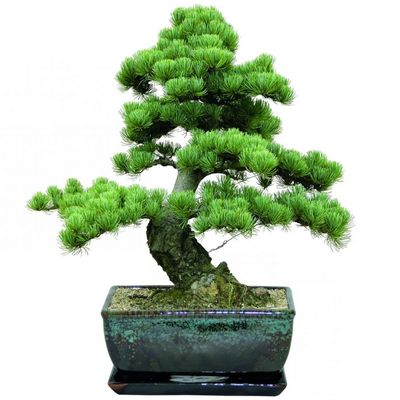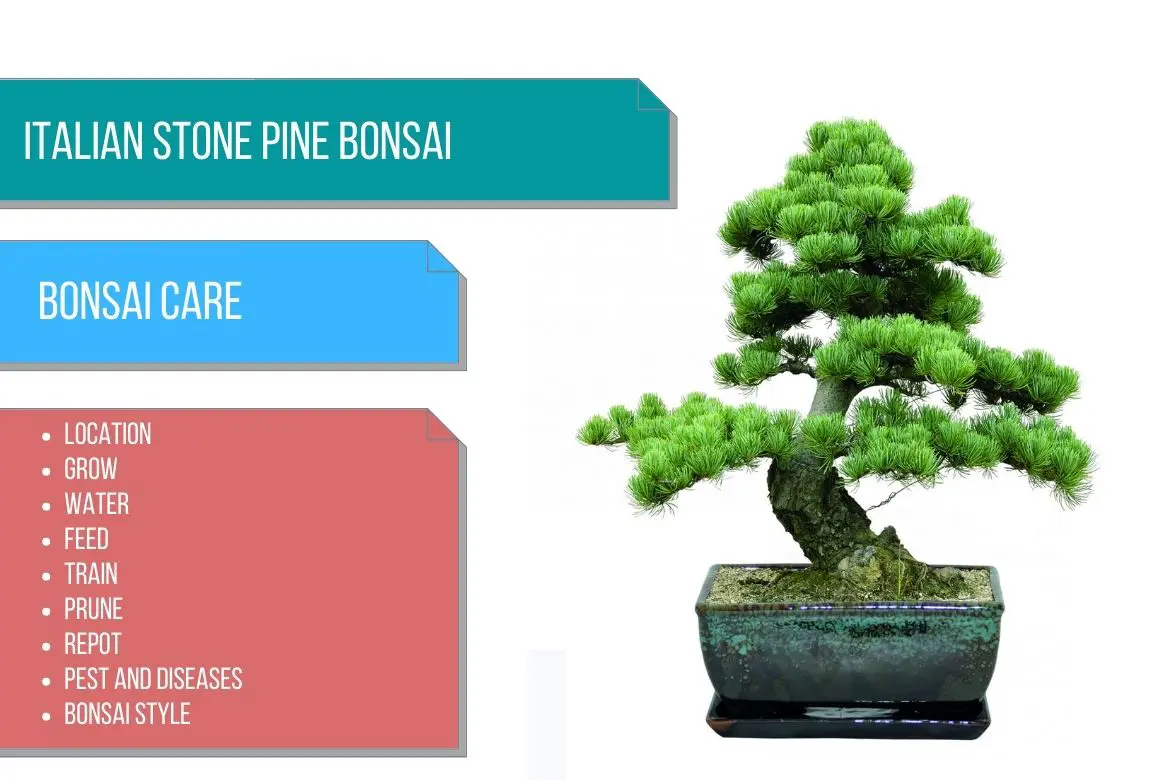
Italian stone pine / Stone pine / Umbrella pine / Mediterranean stone pine
(Pinus pinea)
Country of Origin : Southern Europe
Bonsai Styles : Formal upright, informal upright, semi-cascade, cascade, literati, driftwood, broom
Zone : 8
Italian stone pine is one of the most common pines in Mediterranean regions. It has a dense umbrella-like, flat-topped crown packed with pairs of needles – because of which it is also known as the umbrella pine tree.
When young, needles are light green, and as they mature, they become dark green. These needles are arranged in pairs on the branches and can be 8 inches (20 cm) long.
New shoots of the tree are off green in color. As the branches mature, they will attain a brown color with a gray tint.
Stone pine has tough, dark brown bark that develops deep vertical furrows as the tree ages. Furthermore, the barks of old trees exhibit orange, red and yellow brown colored patches where the bark flakes off.
Can I bonsai an Italian stone pine?
Italian stone pine can be grown into a delightful indoor bonsai tree. Its many characteristics such as its foliage, growth habit of foliage (that can be trained into cloudy foliage pads) and attractive bark, make Italian stone pine one of the most desirable tree species to be grown as bonsai. Furthermore, the fissured bark of the tree adds the illusion of age to the bonsai. Additionally, this is an ideal option for bonsai growers who would like to grow a conifer bonsai tree indoors. However, one key thing to remember is that you can only successfully style this bonsai if it is kept outdoors during the growing season. Also keep the bonsai fairly cold in winter to stop any further growth.
The Aleppo pine bonsai tree is another pine tree that can be grown indoors.
Read more about other bonsai trees species in : Types of bonsai tree
Best location to keep Italian stone pine bonsai tree
Italian stone pine ( along with Aleppo pine ) are the only pine trees that will do well indoors, provided that, during the winter months, they are kept in a cool location. You can also use grow lights. Read how to use grow lights to grow bonsai trees indoor for more details.
Pinus pinea is one of the few conifers that can tolerate a centrally heated atmosphere, at least intermittently.
They can be placed indoors in a bright, sunny position. You should, however, protect them from the midday sun. A west-facing window is an ideal location.
It can also be kept outdoors from mid spring through summer, either on a balcony or in the garden. Keep them in full sun or partially shaded indirect sun.
As mentioned before, keep the bonsai in an unheated room in winter. Keep the temperature just above 32°F (0°C). An ideal temperature range is from 41°F to 50°F (5 to 10°C).
Make sure that the humidity level does not fall below 50%. Please read indoor bonsai tree care for more details.
IMP: Refer to do bonsai trees need sunlight for more indoor and outdoor bonsai location ideas. Also, refer sunlight requirements for indoor plants for more indoor gardening ideas.
Propagation of Italian stone pine bonsai tree
The most common method to propagate Italian stone pine is by seeds. However, it can also be propagated through cuttings.
Take softwood cuttings in late spring or early summer. Apply some rooting hormone and plant it. In few months it should be ready to be transplanted into another pot.
When using seeds, soak the seeds for overnight. Place the seeds in a plastic bag filled with moss and keep the bag in refrigerator for 2-3 months. This will trigger germination. Sow the seeds in a pot and keep the saplings in the pot for almost 1 year. After that, the plant can be transplanted in a different pot.
Watering Italian stone pine bonsai tree
This tree originates from dry Mediterranean regions, hence established Italian stone pine is a drought-tolerant tree. However, young bonsai trees should be watered regularly.
One of the signs that the bonsai is receiving less water is that the foliage will look dull and wilted. Apply water immediately when you notice such symptoms or else it will cause dieback of foliage.
Let the soil become slightly dry before watering again. In winter water sparingly.
You can use tap water.
Read watering bonsai tree (for immersion technique) and indoor bonsai tree care for more details.
Wiring Italian stone pine bonsai tree
Due to its flat, broad crown, Pinus pinea is one of the few conifers that grows naturally in the broom style. It is, however, also possible to develop other styles.
Branches and trunks of young Italian stone pine trees remain flexible for a long time, and wire can be used to shape even three-year-old limbs.
In order to avoid needles getting caught up in the wire, it is advisable to remove the needles from those parts of the tree that will be trained with wires. To prevent damage to the bark, the wire shouldn’t be too tight.
Generally, it is advised that you should wire your stone pine bonsai in winter.
If you have wired the tree in winter, you can remove the wires in mid summer. In case the branches have not attained the desired shape, rewire the branches at that time.
It is also possible to guy down strong branches on older bonsai specimens.
Read : Detailed guide on How to wire a bonsai. This extensive guide includes all the wiring techniques and Do’s and Dont’s. It will also show you other bonsai training techniques which can be achieved without using wires.
Pruning Italian stone pine bonsai tree
When to prune Italian stone pine bonsai tree?
How to prune Italian stone pine bonsai tree?
The needles of the tree can grow quite long, hence a Pinus pinea bonsai must not be kept too small. Or else it will not look proportional.
Even on young shoots, umbrella pine needles can grow to significant lengths. Often you will see very long needles emerging next to shorter needles. It is possible to carefully remove the longer needles by hand in such a cases.
You can pinch back young shoots that have not yet developed needles once they reach 6-8 inches (15-20 cm) with your fingers. As a general rule, shorten them to a third of their length.
Also, it is recommended that new growth in the crown of the tree be pruned more severely than growth further down.
On older bonsai trees, while performing pruning on old branches, if you are planning to prune back to the old woody section of the branch, make sure that there is some foliage left on the branch. Or else, the chances of growing new shoots on that branch will be drastically reduced.
Old needles dry from the inside out. These drying needles should also be removed as they don’t fall on their own.
Read how to prune a bonsai to know about the right technique of pruning and more about defoliating a bonsai tree.
Repotting Italian stone pine bonsai tree
When to repot Italian stone pine bonsai tree?
Italian stone pine bonsai trees can be repotted every 2-3 years in the spring. It depends on the development of the roots.
Prune almost 1/3 of the total root mass. Even though the tree is a slow grower, the roots of these trees grow rapidly.
Use a free-draining bonsai soil mix.
You can also make a bonsai soil mix by mixing loam, sand and peat moss (2:1:1). You can also mix lava chips, fired clay particles and sand in the ratio 1:1:2.
Please check out how to repot a bonsai to know everything about repotting and root pruning a bonsai.
Must Read: Bonsai Soil Recipes
Feeding Italian stone pine bonsai tree
Mature Italian stone pines (around 5 years old) do not require fertilization. However, when the bonsai is young, you can feed the plant every 4 weeks with weak doses of liquid fertilizer during the growing season.
If you suspect that the tree is not developing well, apply some acid fertilizer. Avoid applying fertilizer that is high in nitrogen content.
Do not feed the bonsai in winter.
Read more about bonsai fertilizer and its application. This will also give you more details on how to feed flowering bonsai trees.
Diseases and pest of Italian stone pine bonsai tree
Italian stone pine bonsai is generally trouble-free.
If the bonsai is not taken care of properly – i.e. incorrect watering and fertilizing, the needles will dieback of needles.
Pine needle cast will turn the needles brownish-red in color. Apply a fungicide.
If kept too damp, Italian stone pine seedlings are prone to fungal infestation.
Rarely, bark beetles aka bark miners can also cause some problems. You can apply parathion and lindane–based insecticides.
With age, the foliage of the tree will start yellowing. You cannot do anything about it.
Please make sure you read our comprehensive guide: How to identify and treat bonsai pests and diseases is a great resource for you to see all the organic and inorganic remedies you can use.

